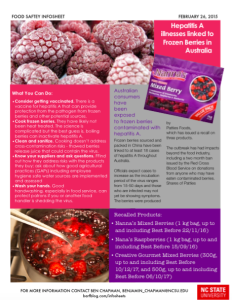Don Schaffner, a prof at Rutgers University in New Jersey, writes: I’m in the barfblog go to guy on hand sanitizer, so when Doug asked me to comment on this story https://www.nytimes.com/2020/06/22/health/fda-Eskbiochem-toxic-hand-sanitizer-virus.html how could I say no?
I have to confess that I had no idea that you could should not use methanol as a hand sanitizer. I do know that only ethanol is for “internal application”, and even then only in moderation. I assumed that methanol was like isopropyl alcohol, in that it would be safe for applying on your hands.
As noted in the story, it’s not technically the methanol itself that’s toxic, it’s the formaldehyde and formic acid that come from methanol breakdown in the body.
The Wikipedia pages for the three compounds do make for some interesting reading.
https://en.wikipedia.org/wiki/Methanol
https://en.wikipedia.org/wiki/Ethanol
https://en.wikipedia.org/wiki/Isopropyl_alcohol
All three pages include information from NIOSH (National Institute for Occupational Safety and Health). While the toxicology data for methanol from NIOSH does give a recommended exposure limit for the skin, NIOSH does not give a similar warning for isopropyl alcohol or ethanol. The Wikipedia page is for isopropyl alcohol and ethanol do both mentioned that they can be skin irritants, however.
In digging a little deeper to try to understand methanol toxicity and the skin, I did come across this article: https://academic.oup.com/occmed/article/42/1/47/1358356 which would suggest to me that the risks posed by these illegal sanitizers are relatively small (unless you are dosing your entire body), but clearly there is a legal prohibition against using methanol in hand sanitizer.
Be sure to read the New York Times story, especially the comments from the company representative Mr. Escamillo who throws the blame on a broker who “had access to our company… and shipped sanitizers”. WFT?
It’s also great to see this article comes from Christopher Mele who called in the midst of my five second rule media blitz to do a very thoughtful interviewhttps://www.nytimes.com/2016/09/20/science/five-second-rule.html At least I hope it was thoughtful, I remember sitting on my back porch and applying some Cabernet Sauvignon internally as we chatted. He called me back later for a story on whether you should take your shoes off in the house too https://www.nytimes.com/2019/08/27/science/shoes-in-house-germs.html.
Many thanks Dr. Don, and Chris has interviewed me a few times as well.









